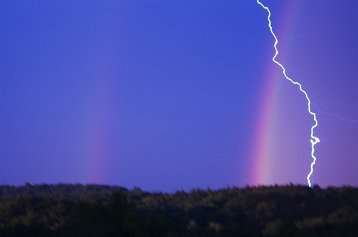 Discovery and the ISS are orbiting Earth. Would you like to see them? Sign up for Spaceweather PHONE.
Discovery and the ISS are orbiting Earth. Would you like to see them? Sign up for Spaceweather PHONE.
NLC ALERT: Last night, Europeans witnessed the most widespread display of noctilucent clouds so far this year. "Sublime." "Fantastic." "The best I've ever seen." Such were the comments of veteran observers. Another display is possible tonight; look west at sunset for electric-blue ripples creeping over the horizon: gallery.
400,000 lb DRAGNONFLY: On July 10th, Torsten Edelmann of of Landsberg, Germany, was photographing the sun when a little black dragnonfly flitted across the scene. On closer inspection, it was a big black dragonfly--the International Space Station (ISS):

The Sun and ISS viewed through a Coronado PST.
The wings of this 400,000 lb. bug are the station's photoelectric solar arrays, stretching 240 feet from tip to tip. Altogether, the arrays contain 262,400 solar cells and cover an area of about 27,000 sq. feet -- more than half the size of an American football field. A computer-controlled gimbal rotates to keep the arrays tilted toward the sun, providing a steady stream of power to the ISS.
DISTURBING THE PEACE: You don't see this every day--a peaceful rainbow split down the middle by a bolt of lightning:

On June 28th, Julie Juratic took the picture as a thunderstorm was winding down over the Cuyahoga Valley National Park in Ohio.
Although we seldom see them together, rainbows and lightning are related. Both are created by rain. Raindrops make rainbows by catching the rays of the sun and spreading them into their underlying colors. Raindrops make lightning by rubbing against ice crystals in thunderclouds. Like socks rubbing against carpet, raindrops rubbing against ice crystals create an electrical charge and--zap!--lightning.
more images: from George Varros of Mount Airy, Maryland.

